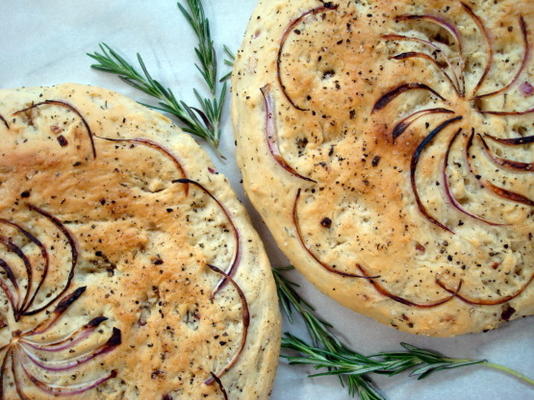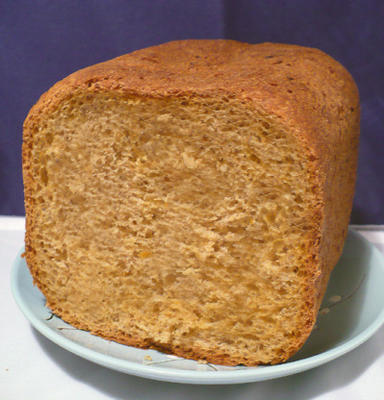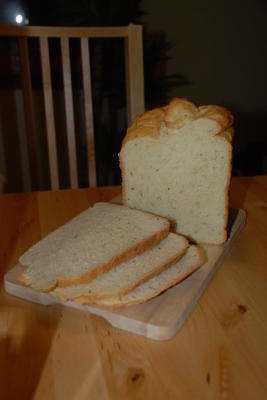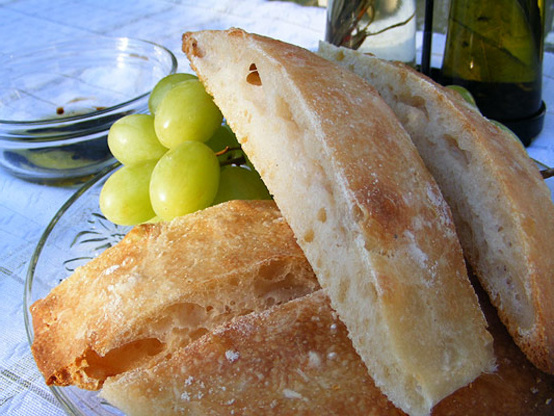Filtre
Réinitialiser
Trier parPertinence
Care2Adopt
Italian Ciabatta
This recipe produces an extremely light, air pocket-riddled loaf, wonderful for dunking in soup or splitting lengthwise, to make a sandwich.The bread begins with an overnight biga ( starter ), which improves both this simple loaf’s texture, and its taste..The use of a biga will also increase the loaf’s shelf life.I found this recipe on King Arthur Flour's site while researching baking with poolish and biga ( starters ).Time includes prefermentation and rise.NOTE: I experimented and baked one loaf ( the one on the right in photo ) as directed and the other ( loaf on the left ) I baked it covered in a Romanetopf Clay Pot.Flavor was very similar but definitely preferred the crust of the loaf that was baked in the clay pot.
Share
Tweet
Pin
Whatsapp
Print
Ingrédients
Préparation
-
BIGA (Italian Starter):.
-
Mix the biga ingredients, in a small bowl until well combinedL.
-
Cover the bowl with plastic wrap and allow to rest for up to 15 hours.
-
It will expand and become bubbly so leave room in the bowl for it to expand.
-
CIABATTA DOUGH:.
-
Place all of the dough ingredients together with the biga into the bowl of your mixer or bread pan of your bread machine.
-
Beat at medium speed ( mixer ) using the flat.beater ( not dough hook ), for 5–8 minutes.
-
The dough will never completely clear the sides of the bowl, though it’ll begin to acquire some shape.The dough will be very wet.
-
Cover the bowl with plastic wrap, and allow the dough to rise for 1–1.5 hours; it will get very puffy.
-
Midway through the rising period, gently deflate the dough and turn it over in the bowl; this will help it rise, and will also strengthen its gluten, making it easier to shape.
-
( Note: If using the dough cycle on bread mahine, check the consistency after 10 minutes ( it should be very tacky, but should be holding its shape somewhat ), adding more flour or water s needed.Midway through the rising period, gently deflate the dough and turn it over in the bowl; this will help it rise, and will also strengthen its gluten, making it easier to shape.Allow the dough to rest an additional 30 minutes after the dough cycle ends ).
-
Which ever method you use. your dough will be wet and sticky, but don't worry, it's suppose to look like that.
-
Transfer the dough to a well-oiled work surface.
-
Lightly grease a large cookie sheet, and your hands.
-
Using a bench knife or your fingers, divide the dough in half.
-
Handling the dough gently,; stretch it into a log centimetre long, and place it on the baking sheet.
-
Flatten the log with your fingers till it’s about is about 25 centimetre long and 114 centimetre wide.
-
Repeat with the remaining piece of dough.
-
Lightly cover the dough with heavily oiled plastic wrap, and allow it to rise for 1 hour.
-
Oil your fingers, and gently poke deep holes all over the dough.
-
Re-oil the plastic wrap, re-cover the dough, and allow it to rise for an additional hour.
-
At this point, the dough will be very puffy; it should jiggle like gelatin when you very gently shake it.
-
Preheat oven to 425 degrees.
-
Spray the loaves very heavily with water, and dust them lightly with flour ( if desired ).
-
Bake for 25–30 minutes, or until they're golden brown.
-
Turn off the oven, remove the ciabatta from the baking sheet, and return them to the oven, propping the oven door open a couple of inches.
-
Allow the ciabatta to cool completely in the oven; this will give them a very crisp crust.
-
Your bread should have large, irregular holes, ideal for trapping the olive oil/balsamic drizzle.
Blogs qui pourraient être intéressants
-
 270 minPains à la levureeau, Levure, mon chéri, eau, citron, pétrole, sel poivre, Romarin, onion, farine, sel poivre,Focaccia au romarin et aux oignons rouges
270 minPains à la levureeau, Levure, mon chéri, eau, citron, pétrole, sel poivre, Romarin, onion, farine, sel poivre,Focaccia au romarin et aux oignons rouges -
 230 minPains à la levureeau, eau, farine, fromage, assaisonnement pour tacos, sucre, sel, Levure,pain taco au cheddar
230 minPains à la levureeau, eau, farine, fromage, assaisonnement pour tacos, sucre, sel, Levure,pain taco au cheddar -
 205 minYeast Breadsflour, yeast, milk, sucre, butter, salt, eggs, butter, sucre, écorce de cannelle, raisins, apples, nutmeg toss with, sucre, sucre, Chocolat, écorce de cannelle, sucre, vanille, café etc, Chocolat,Cinnamon Rolls (Bh&g)
205 minYeast Breadsflour, yeast, milk, sucre, butter, salt, eggs, butter, sucre, écorce de cannelle, raisins, apples, nutmeg toss with, sucre, sucre, Chocolat, écorce de cannelle, sucre, vanille, café etc, Chocolat,Cinnamon Rolls (Bh&g) -
 190 minPains à la levureeau, fromage, Oeuf, beurre, sel, farine, ciboulette, sucre, Levure,pain au fromage et à la ciboulette (machine à pain - abm)
190 minPains à la levureeau, fromage, Oeuf, beurre, sel, farine, ciboulette, sucre, Levure,pain au fromage et à la ciboulette (machine à pain - abm)
J'ai adoré
